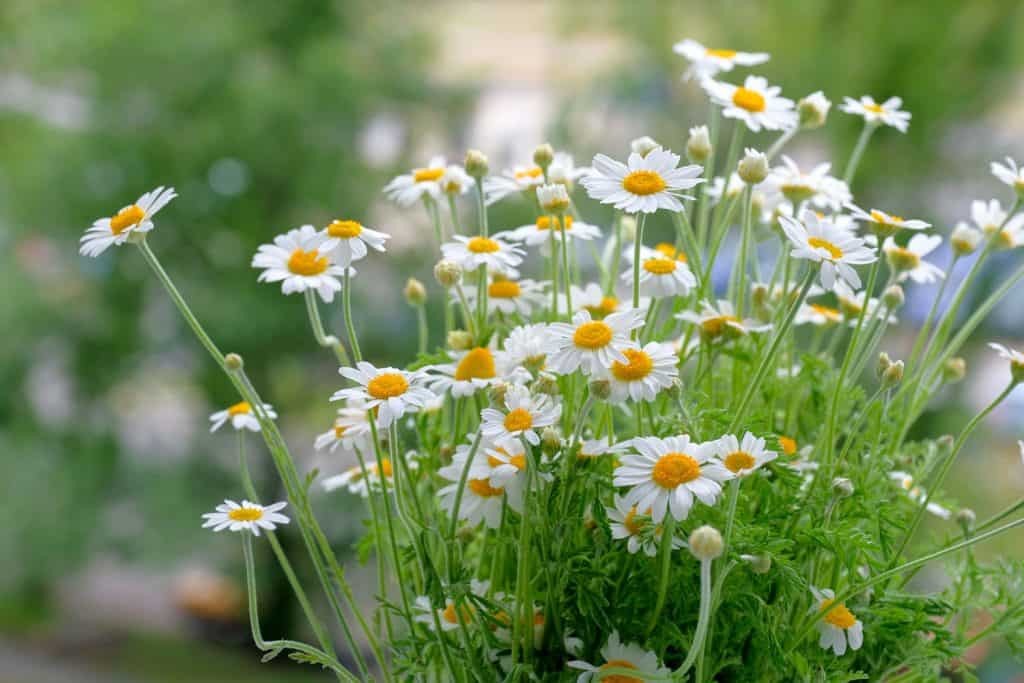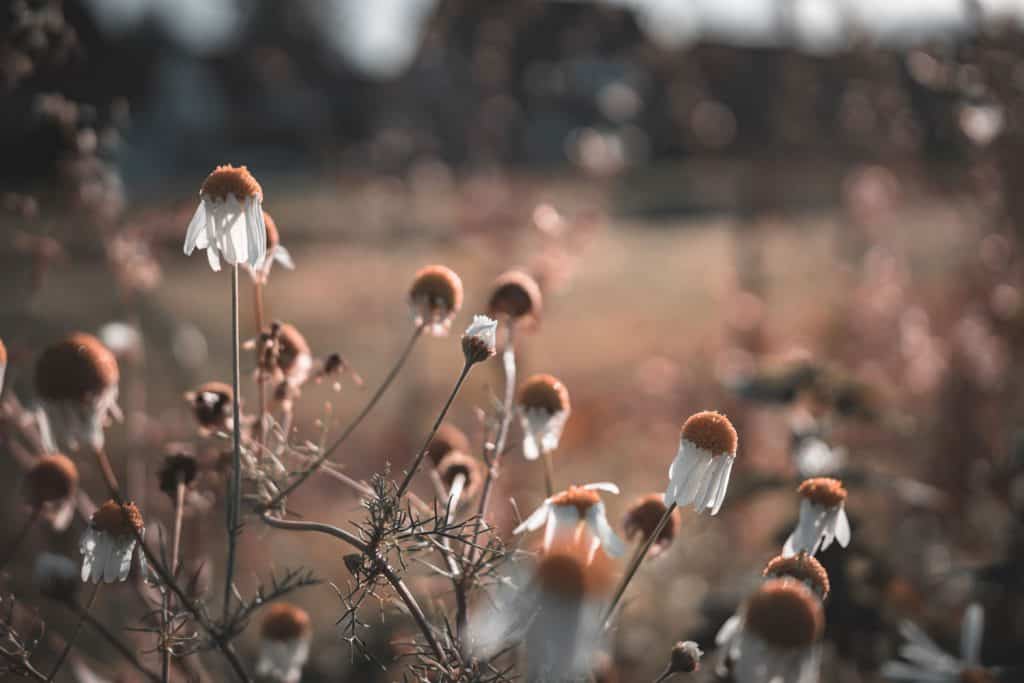One of the great things about gardening is that it can be easily changed. If it turns out that a spot isn’t good for a certain plant, you can just dig it up and move it somewhere else. But the key to doing so is moving it at the right time. In this article, we’ve researched when and how to transplant one of the simplest garden flowers: the daisy.
Depending on the time of year that you decide your daisies need to be transplanted, the best time to do so is during the spring or fall. To transplant them, you will need to either separate them or move the whole clump of them together. Dig up the entire root ball before planting them in their new location.
Transplanting daisies is not hard, but you have to do it right in order to ensure that the daises survive. We’ll explain everything you need to know about transplanting daisies in this article. Continue reading to learn more.
![Gorgeous blooming daises in the summer photographed in the garden, When To Transplant Daisies [And How To]](https://gardentabs.com/wp-content/uploads/2021/12/When-To-Transplant-Daisies-And-How-To_1-683x1024.png)
When Is The Best Time To Transplant Daisies?
Ideally, the best time to transplant daisies is in the spring. However, you can also transplant them in the fall if necessary. But is there a way to know whether or not you should move them in the spring or fall?

Transplanting In Spring
The reason why spring is recommended is so that the roots of the daisy have plenty of time to acclimate to their new environment before the cold temperatures of winter set in. Most daisies bloom from late spring to early fall. By transplanting them from early to mid-spring, they should still bloom on time.
However, you don’t want to wait too early in spring to move them if temperatures are still going to get below freezing at night. If you transplant the daisies and then a freeze comes, the cold weather could kill them before the roots have time to acclimate.
It’s best to wait until after the last frost if you’re going to transplant daisies in the spring. That way, you can ensure that the newly transplanted flowers will survive. In most cases, the end of April or the beginning of May is a good time to transplant them.
Transplanting In Fall
If you forgot to transplant your daisies in the spring and they have already started to bloom, you can also transplant them in the fall. However, you’ll want to make sure that they are finished blooming first.
Moving daisies during the blooming season can interfere with their bloom. That’s why you shouldn’t move them during the summer. Plus, the hot summer temperatures can be stressful on the daises if they are moved at that time.
It’s important to remember that daisies are perennial plants, so they will come back the next year if their bloom is interrupted. However, if you want to enjoy the full blooming season, then it’s best to wait a couple of weeks after fall has started to move them.
But just as you didn’t want to transplant them too early in spring, you don’t want to transplant them too late during fall. September to early October is a good time to transplant them, depending on where you live and how soon it gets cold.
At the absolute latest, you will need to transplant daisies about two weeks before the first predicted frost. This will give them time to acclimate before the freezing temperatures come. If the first frost has already passed, you will need to wait until spring to move the daisies.
See More: When To Transplant Coneflowers - And How To
Do Daisies Transplant Well?
Daisies are easy to transplant, and they transplant very well. However, as with any plant, they can undergo stress when moved to a new environment (much the same way that people do).
They also have to have time to acclimate to their new environment, so it is important that you move them at the right time of year. That way, they won’t go into shock as a result of getting too hot or too cold, which could ultimately kill them.
In addition to transplanting them at the right time of year, you also have to make sure that you transplant them the right way. Providing the right care after transplanting is also essential for their survival.
It may seem like a lot to remember, but these are the same procedures that you have to follow when transplanting any plant. Daisies will transplant very well as long as the transplanting is done properly.
How Do You Transplant Daisies?

Now that you know when to transplant daisies, you need to know how to transplant them. Luckily, it is a very easy process. Just follow these instructions, and you should be able to move your daisies with no problems.
1. Prepare The New Location
The first thing that you’ll want to do is find and prepare the new location to which you want to move your daisies. Daisies require full sun, so you need to find a location that receives at least six hours of sunlight per day.
Once you’ve picked out a location, remove any weeds or grass that is growing in the area. Then, use a hose or watering can to thoroughly moisten the ground, which will help the roots acclimate to the soil better.
2. Dig Up The Daisies
Next, you’ll want to dig up the daisies from their current location. When you do, make sure to dig at least 5 inches in all directions around the plant. This will ensure that you get enough of the roots. If you don’t get enough of the roots, the plant may not take to the new soil.
When you dig up the daisies, you’ll also want to be sure that you dig up as much of the root ball as possible. Avoid the temptation to remove dirt from the root ball. Not digging up enough of the root ball and removing dirt from it can damage the roots.
3. Plant In The New Location
In the new location, dig a hole that is twice as deep and twice as wide as the root ball. Place the daisies into the hole and cover them with dirt. You can also add some compost if you want. Water the area again thoroughly to help hydrate the daisies.
See more on our post: How And When To Transplant Black-Eyed Susans
When Can You Split Daisies?
The best time to split daisies is in the spring or fall, whenever you transplant them. However, you may wish to wait until after the plants have bloomed in the fall in order to give smaller plants plenty of time to become established before the next growing season. Again, just be sure to do it before the first frost.
When splitting daisies, you want to make sure that you keep as many of the roots intact as possible. With the root ball in your hand, gently pull the plants apart to separate them. When planting them, follow the same instructions as above.
Do Daisies Spread?

Daisies are very fast-growing plants, and they will spread. Whether planting them initially or transplanting them, it is a good idea to give them plenty of space to grow if you don’t want to have to split them every year.
It’s best to keep daisies contained in a separate flower bed. That way, they won’t spread as much and overtake other plants. If this happens, it can negatively affect the growth of the other plants.
How Do You Take Cuttings From Daisies?
To take cuttings from daisies, you will need to do so in the fall. Cut a stem that is between four and six inches long. Remove any leaves from the lower half of the stem, then dip the stem in a rooting hormone. Place the stems into a pot with soil or a prepared propagation medium.
Keep the soil moist and store the cuttings in an area that receives indirect sunlight. Over the course of a few weeks, roots should begin to grow on the cuttings. Transplant the cuttings into the ground during spring.
Click here to see this rooting hormone on Amazon.
How Do You Collect Daisy Seeds?

You can also collect the seeds from daisy plants in order to regrow them. To do this, you will need to wait until seed heads develop after the plant finishes blooming in the fall.
Cut off the seed heads and collect them in a bag or cup. Once the seed heads dry out, gently squeeze them to release the seeds. Plant the seeds in a seedling tray or sow them directly onto the ground in the fall or spring.
Conclusion

We hope you found this guide helpful for transplanting daisies. It’s not hard to do; you just have to make sure to do it at the right time and in the right way. If you don’t want to transplant the whole plant, you can also take cuttings or seeds from the existing plant. Thanks for reading!


Very informative. Thank you.
Thank you for this very informant article on Daisies and Black-eyed Susans. Great information on all aspects off these plants. I did know alot of this information. I will be relocating these plants in the near fall and feel confident i have all the info i need. Thanks again!!
What happens if my only opportunity to get the plants is after the first frost? Should I place them in a pot and hold off until spring? Move them to the garage and once they acclimate to garage, maybe put them in the basement? Is that possible? Or maybe in front of the window in the shed so that the temperature won’t be a shock & they will still get sunlight but they won’t get any snow on them so maybe I should still keep them watered?